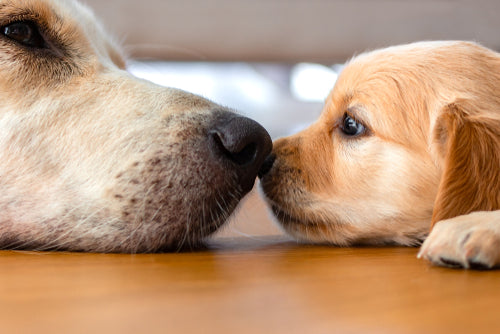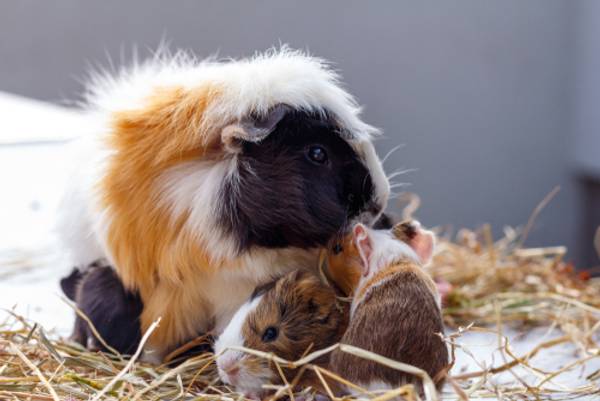You’ve hidden your slippers, stocked up on pet food, set up a sleeping area and secured the yard. But there’s one extra step existing dog-owners need to plan for when they’re bringing home a new puppy. A carefully executed meeting between older dogs and new pups can be crucial for future harmony in the home.
It’s important to begin with realistic expectations. Just like humans, not all dogs will immediately warm to others. Older dogs may feel territorial and protective of you and your home, or they may feel rattled by the energy of a rambunctious puppy. Meanwhile, a puppy might feel scared, nervous or confused in new surroundings. Being aware of the potential and possibilities sets the foundation for a successful introduction.
Step one: Health checks
Before you introduce your dog and new puppy, it’s vital they’ve both been checked over by a vet. This includes being up-to-date with vaccinations and worming. If your new puppy is too young to be vaccinated, you should wait until they’re older and have had their vaccinations before allowing them to come into contact with any other dogs. Now is also the time to make sure both dogs are clear of fleas and other parasites that may be transferred from body to body. And if either pet is showing any signs of illness, seek treatment immediately. Disease is something you don’t want your dogs to share.
Step two: Select a neutral location
Most pet behaviour experts recommend the first meeting between your dog and puppy should take place in a neutral location. This might be a friend’s home, a park, or quiet public venue. Choose somewhere neither dog is familiar with, and try to make it free from distractions like passing traffic, crowds of people, or other animals. Meeting in a neutral location is particularly important for your older dog, because they won’t feel territorial or protective of their home turf.
Step three: Safety provisions
Even if both dogs are happily wagging tails, it’s important to proceed with caution. Consider a ‘fence meeting’ in which each dog is positioned on opposite sides of a fence or similar barrier. This allows the animals to follow their noses and enjoy each other’s scents without directly touching one another. If the dogs are meeting in an open space with no barrier between them, make sure they’re leashed and controlled by separate handlers.
Step four: Parallel walking
Continue the meeting with separate handlers controlling each dog. The handlers should try walking the leashed dogs side-by-side, also known as parallel walking. Don’t hold the leashes too tight so that the dogs can move relatively freely and keep a safe distance from one another if they choose. Take the walk slowly and let the dogs explore and sniff each other in their own time. Reward positive behaviour with praise or treats.
Step five: Beware of body Language
If, at any time, the dogs are displaying signs of aggression, anger, fear or agitation, calmly intervene by diverting the dogs’ attention and separating them. Signs that dogs aren’t coping include hair standing up on their back or neck, gnashing teeth, growling, stiff legs, cowering, an under-curled tail, or intense and prolonged stare. Pay particular attention to your older dog whose upset behaviour would be more familiar to you.
Step six: Move to your home
After a successful meeting in a neutral location, repeat the same steps in an outdoor area of your property. If your yard is fenced, you can unleash the dogs, but regularly call them apart so they don’t get overly excited. If you have more than one older dog at home, you should only be introducing the puppy to one dog at a time.
When you’re ready to move inside the home, clear the indoor space of any toys or food that could lead to potential fights. Then pre-occupy your older dog outside. Take the new puppy indoors first and out-of-sight of the older dog. This method will make your puppy feel comfortable to explore the new space, while the older dog will be too busy to feel protective or territorial. Once the puppy has had enough time to explore, bring the older dog inside too.
Step seven: Controlled playtime
Continue to monitor both dogs closely when they’re sharing space indoors. It’s a good idea to set up controlled playtime instead of letting them become over-stimulated by being together all the time. Forced time apart gives the dogs time to settle down and enjoy their own space.
Step nine: Separate when you’re not there
The dogs will eventually reach a stage where controlled playtime is not required, and they can be left together unsupervised. However, in the early days, it’s smart to separate the older dog and puppy when you are not in the home. This can be achieved by placing the dogs in separate rooms, or you can set up security barriers, like toddler gates, that can be used to create separate indoor spaces for the dogs. Work up gradually to feeling comfortable enough to leave the dogs together when you’re out. If you come home to upturned and chewed furniture, that’s a good sign you’ve been too hasty in leaving them together unsupervised.
Step ten: Don’t neglect training
Remember to give your new puppy the same training attention paid to your older dog when you first brought it home. It’s a common trap for dog owners to assume their puppies will learn from their older dogs, or not need as much official training. Establishing early boundaries and routines with puppies will help them settle into any family, regardless of whether there’s an existing dog in the mix.
If all else fails and your older dog and new puppy simply aren’t getting along, remember there is no shame in seeking professional help. Vets and pet behaviour experts like trainers will have plenty of extra tricks up their sleeves to help your pets get along.
Speak to your local Just For Pets independent pet store for advice and training tips. And a range of puppy safe toys, treats and all the goodies you will need to keep them healthy, safe, and happy.






